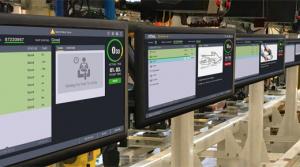All Features

Jane Stull
As companies seek to gain efficiencies in the workplace, provide choice for employees, and attract and retain talent, strategies involving agile working and free-address have gained traction. When our Gensler La Crosse office relocated last year, we leveraged the opportunity to support an agile…

Thomas R. Cutler
Although automation has been successful in replacing repetitive, simple tasks, the human workforce still plays a critical role in manufacturing. Even the most sophisticated and automated manufacturing operations rely on human operators to configure, run, and properly maintain production equipment…

Aiman Sakr
Does your organization benefit from lessons learned? Does it learn from previous quality issues? A vast amount of learning takes place every day in every manufacturing facility. Do global manufacturing companies share experiences gained from resolving quality issues between overseas plants? And…

Jim Benson
I love to cook. When I make good food and share it with others, they will take a bite and look as excited to eat it as I was to create it. They might not understand the subtleties that went into it, but they understand the product. Satisfied eater, satisfied chef.
When we do something and are…

Taran March @ Quality Digest
We are here, and it is now. Further than that, all human knowledge is moonshine. —H. L. Mencken
I ran across the term “moonshine shop” while reading about a kaizen blitz at Ontario-based communications firm Cogeco. “Brad, [Cogeco’s] maintenance leader, coordinates all projects relating to modifying…

Harish Jose
I have written about sample size calculations many times before. One of the most common questions a statistician is asked is, “How many samples do I need—is a sample size of 30 appropriate?” The appropriate answer to such a question is always, “It depends!”
In today’s column, I have attached a…

Russell Fedun
Cogeco’s technical distribution center in Burlington, Ontario, is one of Canada’s drop-off points for internet modem and cable device repair. In 2011, the company’s management carried out a kaizen blitz to improve the efficiency of its device repair process. The process was indeed challenging but…

Ryan E. Day
Business partnerships are nothing new. Partnerships that result in leaner manufacturing processes, more consistent quality, and lower manufacturing costs—that is worth talking about.
With global competition so fierce, manufacturers must always be keen to spot areas of muda (waste). Even seemingly…

Jim Benson
Let’s take a second to emphasize who is important in the following quotes, all by W. Edwards Deming: “If you can’t describe what you are doing as a process, you don’t know what you are doing.” “A bad system will beat a good person every time.” “Drive fear from the workplace.”
Well, by golly, it’s…

Bruce Hamilton
Many years ago, the Toyota Production System Support Center (TSSC) introduced a visual measurement device to my factory, referred to as a “production activity log” (PAL), also known to some as an hour-by-hour chart. Posted at the last operation of a particular process, the PAL provided an up-to-the…

Bruce Hamilton
Three years ago I wrote an article titled “The Emperor’s New Huddle Boards,” in which I expressed concern about the trappings of improvement without actual improvement. Since then, my concern about the application of leader standard work and gemba walks has deepened as these potentially valuable…

Bruce Hamilton
Last month I joined Eric Buhrens, CEO at Lean Enterprise Institute (LEI), to host a leadership team from Tel Aviv’s Sourasky Medical Center. They were on a study mission to many of Boston’s fine hospitals and were winding up their week with a visit to LEI. Early in the discussion, one of our guests…

Grant Nadell
Boeing is demanding its suppliers reduce their prices by 10 percent, according to a February 2018 article published in Bloomberg Businessweek. It’s a hard pill for many to swallow, given that that these cuts are on top of the roughly 15-percent cuts demanded in 2012, when the company launched its…

Mark Rosenthal
A couple of weeks ago I posed the question, “Are you overproducing improvements?” and compared a typical improvement “blitz” with a large monument machine that produces in large batches.
I’d like to dive a little deeper into some of the paradoxes and implications of 1:1 flow of anything,…

Harish Jose
I have been writing about kaizen a lot recently. It is a simple idea: change for the better. Generally, kaizen stands for small incremental improvements. Here I’m going to look at what is the best kind of kaizen.
The twist in the dumpling
A few posts back, I talked about the order for kaizen,…

Willie L. Carter
Becoming a process-focused organization requires a sustained effort, and for most industrial and service organizations that is a difficult task. Failure to improve the performance of your processes leads to a failure to improve the organization and results in improperly managing the business.
All…

Kevin Meyer
One of my great pleasures is going for a walk on the six-mile-long and generally empty beach a couple blocks from my house. There’s the remnant of a long-dormant (hopefully!) volcano at one end that is strangely humbling. A long walk in such a beautiful spot creates a connection between nature, my…

Mark Rosenthal
Imagine a factory with a large monument machine. It takes several days to set up. When it does run, it runs very fast, much faster than you can actually use its output. Therefore, you take the excess output and store it to use later. Actually, you don’t know how many items you need to make, so you…

Gwendolyn Galsworth
The six core questions you see below are a window to help us understand why we struggle at work. Why? Because the answers to them are missing! The remedy is to first notice that—to notice the motion caused by those deficits. Then remove the motion by implementing visual answers. Imbed the answers…

Bonnie Stone
Dramatic cost savings. Lead time and inventory reductions. Improved transactional processes. Although lean has its roots in manufacturing, nearly every industry and type of organization around the world can benefit from it. A little while back, we reviewed the “Five Critical Lean Tools” that are a…

Benjamin Kessler
The rise of the independent worker is arguably the biggest change to hit the global labor market in decades. Well more than 30 percent of the United States workforce reportedly lack “real jobs” working full-time for a conventional company, and that figure, some say, may top 40 percent by 2020. If…

Debashis Sarkar
The cheating at Kobe Steel shook not just Japan but the entire manufacturing world. As Kobe Steel CEO Hiroya Kawasaki revealed, about 500 companies had received its falsely certified products, which affected not only those companies but also its entire supply chain. However, the issue at Kobe was…

Manfred Kets de Vries
According to the most recent report of the Economic Policy Institute, the average CEO-to-worker pay ratio in the United States has gone down from 286 to 1 (in 2015) to 271 to 1 (in 2016). This number may disappoint many top executives who were hoping to see it return to its peak of 383 to 1,…

Ryan E. Day
In part one of this article, we explored how Woodland Trade Co. (WTC) leveraged high-accuracy portable CMMs to help land tight-tolerance aerospace contracts, and even earn Boeing’s Supplier of the Year award. Here in part two, WTC’s QA manager William Shanks reveals the advanced technology that…

Jason Furness
In a previous article I wrote about the reasons why so many lean manufacturing, Six Sigma, and other improvement programs fail. In this article I’m going to expand on reason No. 1: the Academy Award Syndrome.
Academy Award Syndrome
The Academy Award Syndrome is where a program or project is…